After leaving from the meditation center, I had just one day left before I would have to cross the border of Thailand before overstaying my thirty day visa. We decided we would head to Cambodia to see Siem Reap and the Angkor Wat temples since it was so close to where we already were after leaving from the meditation course and it was only a three hour bus ride to make it to the border which went by fairly quick even though I had to stand up for two out of the three hours of the journey since they oversold the tickets on the bus.
Once we crossed the border, you could immediately see the difference between the two countries but it wasn’t until I spent the first couple days in Cambodia before I was able to accurately compare it to countries I’d been to in the past six months.
Cambodia seemed to have a bit of the chaos on the streets that you would find in India though the people here were as friendly as those you would find in Nepal. And after spending time in both those two countries, I quickly realized how poor of a country Cambodia is when compared to Thailand. When I exchanged my Thai Baht currency crossing over the border, I had given them about 1,700 Baht which was the equivalent of about $56 USD. How much in Cambodian Riel did I get back? $224,000! A quarter mill… how long would this last me? Well, after spending six days in Siem Reap, I was tempted to title this post “Cambodia – Where just about everything is $1”. Even though the national currency is the Cambodian ‘Riel’, their common currency is actually the U.S. dollar. It is accepted everywhere, almost everything is priced in dollars and the ATM’s only spit out US Dollars, well, at least in Siem Reap. However, if you need change from a dollar, they will give you their Riel in notes as there are no U.S. coins used here.
And seriously, you can get almost everything for a $1 here. The only thing that will cost more is your hotel room which will run between $3 to $10 a night for an average place and the $6 room I had was actually nicer than most I’d stayed in in Thailand, India and Nepal. So what can you get for a dollar? How about a 20 minute massage, a pitcher of beer, a full plate of food, a tuk tuk ride across town and even a fish foot message that includes a beer (Please See Below).
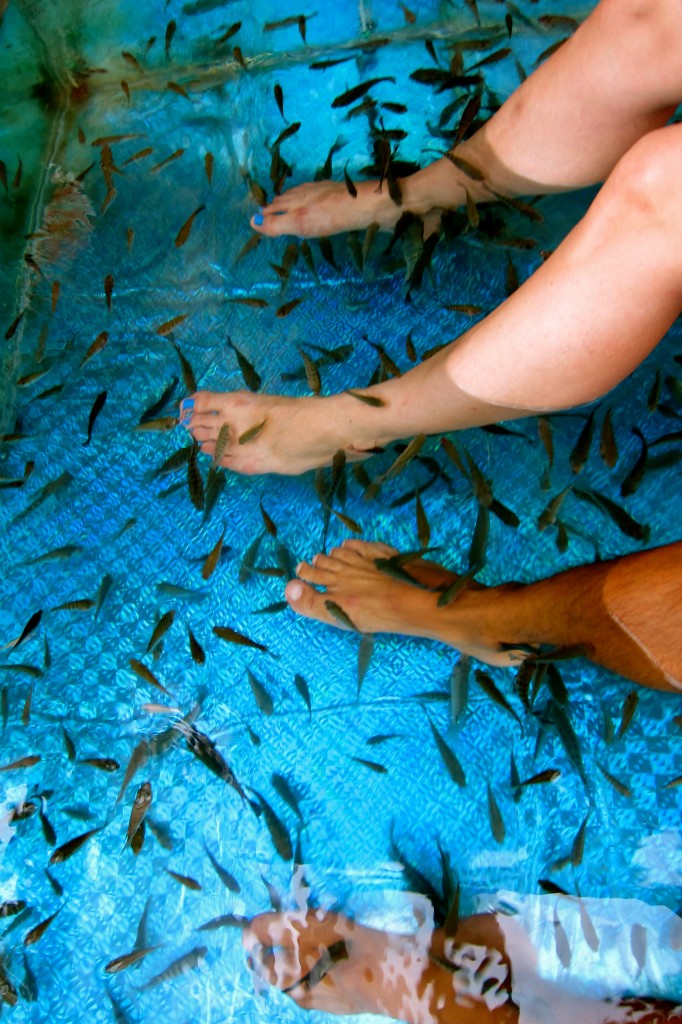
I may fail miserably to try and describe the feeling of having a hundred fish biting your legs so I’ll let you use your imagination…
As the title to this post reads, Siem Reap is home to the Angkor Wat temples and it is one of the main reasons the country gets so many tourists every year. The Angkor Wat temples are so important to the country that they actually portray it on their national flag. There are actually quite a few things to do in and around the city but there is no doubt that the Angkor Wat temples are the main attraction.
For all the Angkor Wat temples combined in the complex, it makes up about 400 square kilometers. The ticket office actually sells one day, three day and seven day tickets due to the sheer size of it. We actually spent two days there but looking back on it, I should have spent three days or more touring the dozens of temples.
Angkor Wat, meaning ‘City Temple’ was built by King Survavarman the 2nd back in the 1100’s. Its main purpose was to serve as his temple and capital city and it was originally used for Hinduism. But over the next 200 years, it gradually moved from Hindu use to Buddhism which continues on into today.
Since it was so cheap to rent bikes (remember, almost everything is $1), we rented a couple for the day and rode to Angkor Wat that first day to catch the sunset and walk around the temple. 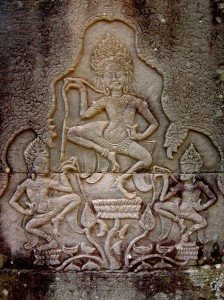 It was only about 17 kilometers from the city and the ride out there was nice as it was a relatively quiet stretch of road and shaded by some of the biggest trees I had ever seen. We did make it in time for the sunset but had about an hour before hand to tour the main temple which is actually Angkor Wat itself. It is surrounded by a moat and an outer wall that stretches over two miles long so you can imagine how large this place is and how long it takes just to see this one temple. As the security guards began asking us to head back out of the temple for closing, we caught the sunset just as we were passing over the bridge that crossed the moat that surrounded the temple. It was nice but it was setting in front of the temple, not behind it so I knew the sunrise the next morning would be much more dramatic and I had been told by many people to be sure to catch it there if nothing else even though it required an extremely early morning wake up call!
It was only about 17 kilometers from the city and the ride out there was nice as it was a relatively quiet stretch of road and shaded by some of the biggest trees I had ever seen. We did make it in time for the sunset but had about an hour before hand to tour the main temple which is actually Angkor Wat itself. It is surrounded by a moat and an outer wall that stretches over two miles long so you can imagine how large this place is and how long it takes just to see this one temple. As the security guards began asking us to head back out of the temple for closing, we caught the sunset just as we were passing over the bridge that crossed the moat that surrounded the temple. It was nice but it was setting in front of the temple, not behind it so I knew the sunrise the next morning would be much more dramatic and I had been told by many people to be sure to catch it there if nothing else even though it required an extremely early morning wake up call!
Following this advice and wanting to get an ‘early’ start on the day, we left at 5AM for the temple on our bikes. How crazy was this?
Well, there were still people in the streets that were coming back from the bars the night before! We found a place that was open for breakfast and ate as quickly as we could so we would’ t miss the sunrise as we were told it rises close to 6AM and we still had a thirty minute ride ahead of us. After eating breakfast, which consisted of french bread, cucumbers, pickles, onions, tomatoes, some eggs and chili sauce (the breakfast of champions) we got back on the saddles and rode off.
Pulling up to the temple though, we were not the only crazy ones out here that morning! There were hundreds already lined up along the waters edge in front of the temple and the sun was just starting to peak over the top of the temple.
After taking way too many photos, we rode further into the area of the temples of Angkor.
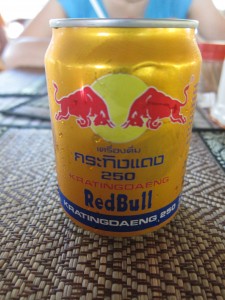
What do you do at 10AM when you’re tired and hungry from riding a bike for the past 5 hours? You order fried rice, the cheapest thing on the menu with amusement park pricing and a Cambodian Red Bull – hold the Vodka.
After we rode for just the first few hours, I quickly realized why they have 3 and 7 day passes to the temples. The area surrounding the temples is huge and spread out. By lunchtime we had already ridden about 50 kilometers and had only seen about a third of the temples in the area. Each we visited was different from previous ones though the architectural design was obviously similar between them all. It was nice to see these others though as there were far fewer tourists outside of the main temple of Angkor Wat and there were even a couple temples we visited where we were the only ones walking around.
I definitely do not regret having toured the area by bike but by the time the afternoon sun got overhead, we had already been riding about 7 hours. 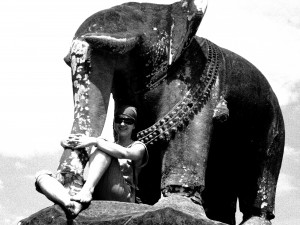 And by 4pm that day, we called it quits and only missed one temple out of about twelve we’d already been to. I wasn’t sure yet if I wanted to buy another day pass but for today, I was ‘templed’ out. Or maybe I was just ready to get off the bike. By the time we started to head back to town, we’d ridden at least 85 kilometers but we didn’t get very far from the temple when I popped a flat…
And by 4pm that day, we called it quits and only missed one temple out of about twelve we’d already been to. I wasn’t sure yet if I wanted to buy another day pass but for today, I was ‘templed’ out. Or maybe I was just ready to get off the bike. By the time we started to head back to town, we’d ridden at least 85 kilometers but we didn’t get very far from the temple when I popped a flat…
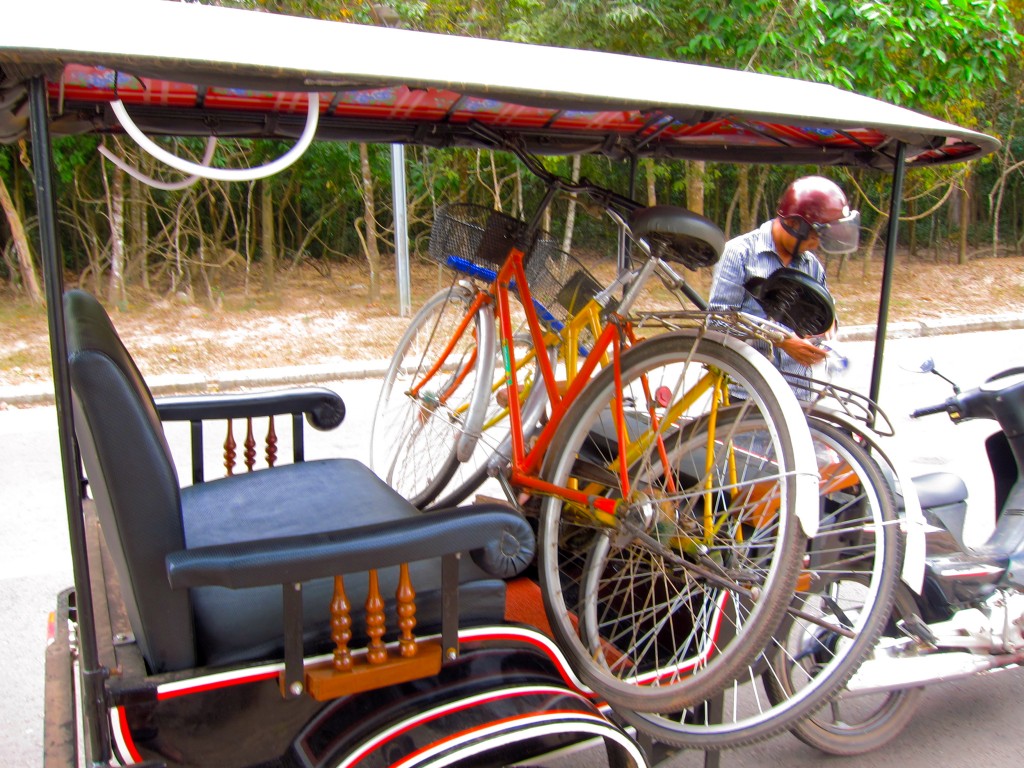
What you do when you’re bike pops a flat 8 kilometers from town? You spend ten minutes trying to convince a willing tuk tuk driver to bring you (and your bikes) back into town at no extra charge…
On another day we left for a visit to the Cambodian War Museum. I didn’t really know what to expect at this museum but I knew that Cambodia had recently been at war and the locals were still feeling the effects of it and living in the aftermath every day.
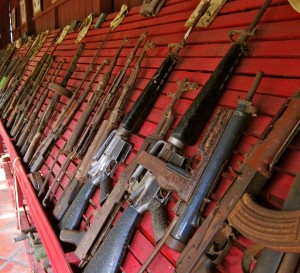 The country had officially been at war until 1979 but its civil war carried on until around 1990. And you couldn’t help but notice the countless victims of this war every day. There were amputees everywhere throughout the city and in the neighboring towns. The locals would even sell paraphernalia from the war as well as clothing and signs that displayed messages of the land mines that still existed in the outlying areas of the city.
The country had officially been at war until 1979 but its civil war carried on until around 1990. And you couldn’t help but notice the countless victims of this war every day. There were amputees everywhere throughout the city and in the neighboring towns. The locals would even sell paraphernalia from the war as well as clothing and signs that displayed messages of the land mines that still existed in the outlying areas of the city.
After walking the museum, we were headed to the Artisans d’Angkor which was a silk farm about thirty minutes outside of Siem Reap. It was completely free to visit and although this wasn’t really my kind of place to sight-see, it was still interesting to see how the whole process of making silk fabrics was done and how the organization supported the local people.
There was a hut on site which held thousands of silk worms from just a few days old to maturity and it displayed the entire process of how the cocoons formed and the 47 day life cycle of the silkworms and how the material was used. They also had a few buildings where the local Cambodians were working on either spinning the silk or actually manufacturing different fabrics from the material.
Here is a short video showing one of the Artisans d’Angkor processes:
And if you’re planning a trip to Siem Reap and what to check out this place, follow the link to the Artisans d’Angkor
While in Siem Reap, we also decided to get out of the city for a day and took a trip to Tonle Sap Lake.
We rented bikes again and the ride took about an hour to actually reach the water. Since we didn’t want to pay the cost of a tour on Tonle Sap lake, the plan was to jump on a boat when we got to the shore but even the government that was running the boat operation was trying to charge way too much for tickets. So much for $1 pricing out here; they wanted $20 just to go out on the boat for an hour or two. Wanting none of that nonsense, we hoped back on our bikes and rode to the very end of the peninsula we were on, away from the boat docks. The further we rode, the more and more locals we encountered and we hadn’t seen a tourist in almost hour.
When we finally made it to the end, we were surrounded by local Cambodians living on the water and talked one of them into taking us around on one of their small boats which was really more of an unstable canoe which I quickly found out. It was a quick ride but just long enough to give the full effect of what conditions are like for these locals living on the water.
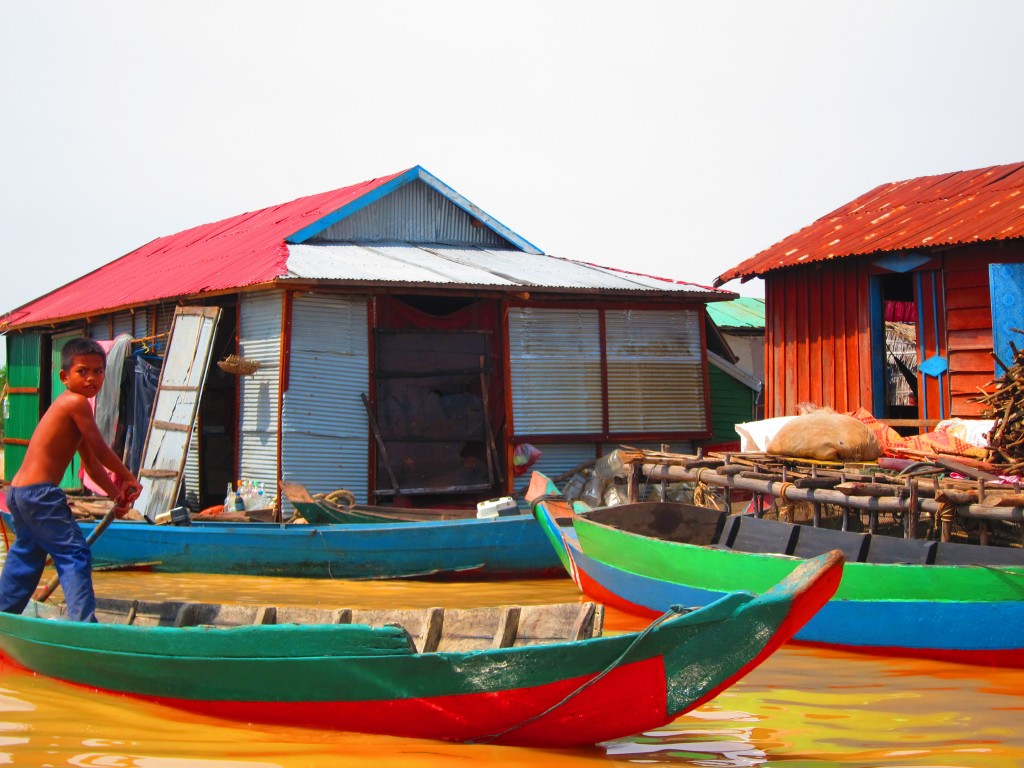
There were boats with props but you couldn’t put them too far into the water as it was only about two feet deep.
On the ride back, we thought it could be interesting to stop at the crocodile farm we’d passed on the way out that morning. It was only a couple dollars to get in and since I’d only been to a place like this once before in Florida, which was mostly alligators, I figured why not.
It was about the same experience but the major difference between the two was that you were able to feed the crocodiles here in Cambodia. 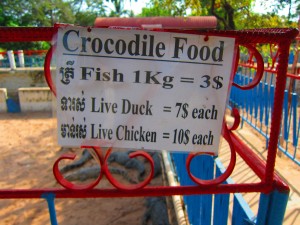 Not only feed them, but feed them live animals. Sorry, didn’t grab any pictures of that….
Not only feed them, but feed them live animals. Sorry, didn’t grab any pictures of that….
So after about six days here, it was time to head back to Thailand. I hated to leave so soon and wanted to travel south into Cambodia towards Phnom Penh but I was meeting a friend in south Thailand in about three days and I’d have to make another stop in Bangkok on the way. Time to prepare for another fun border crossing….






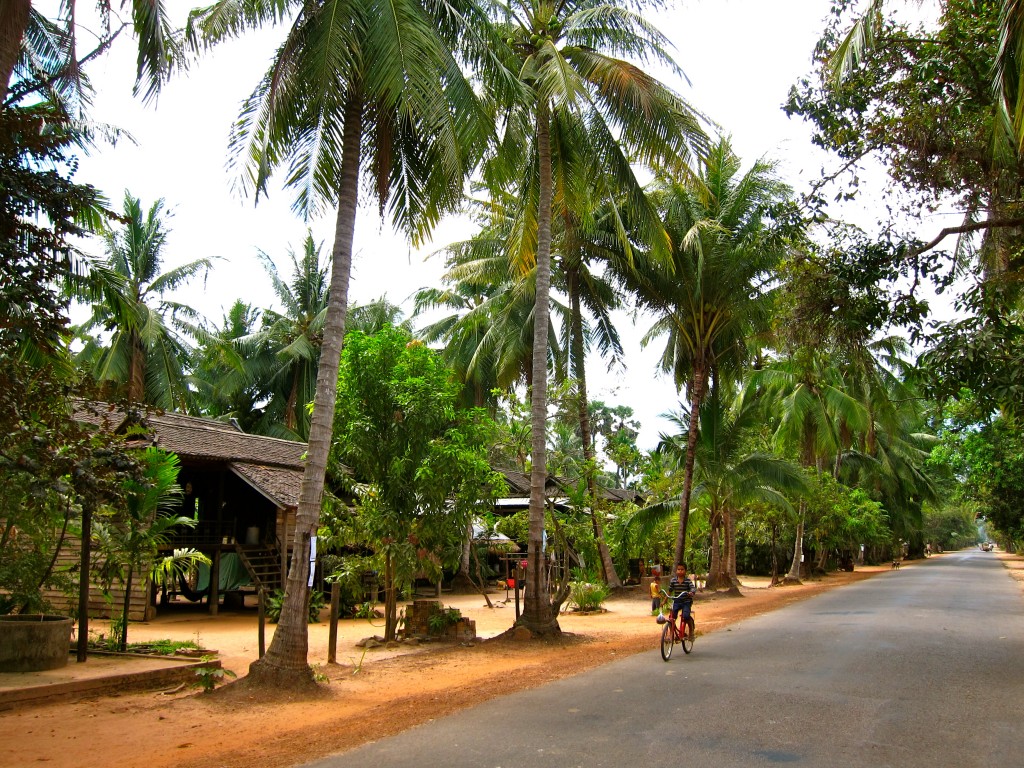
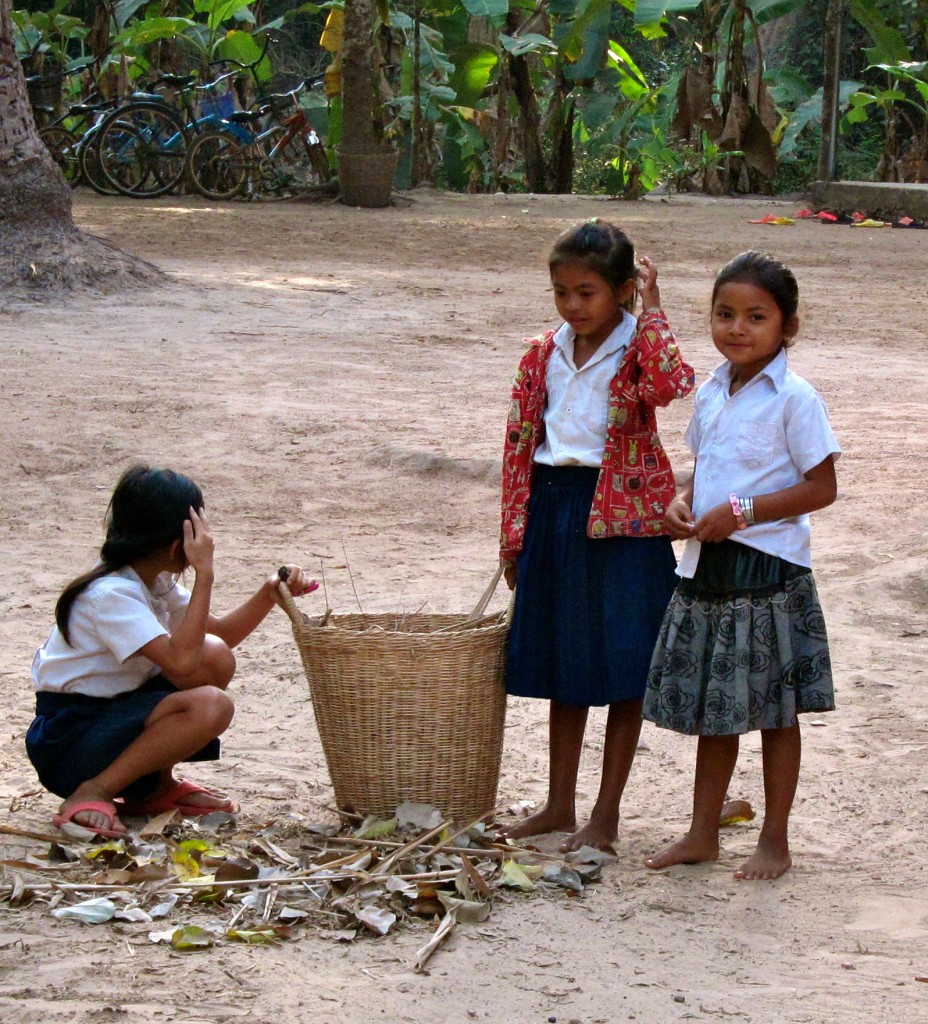
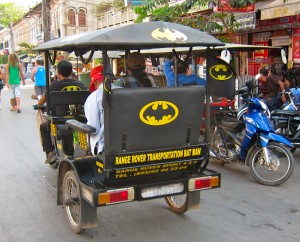
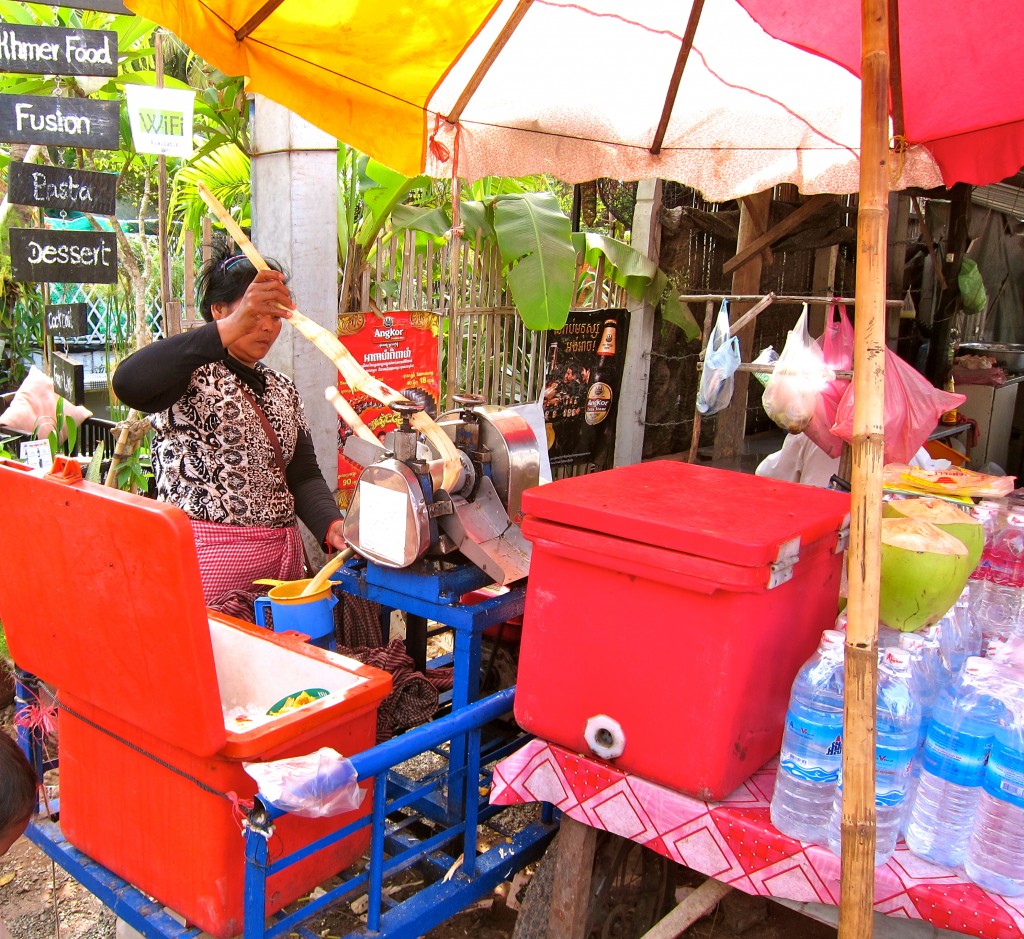
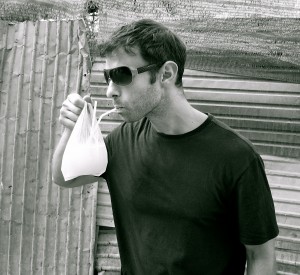
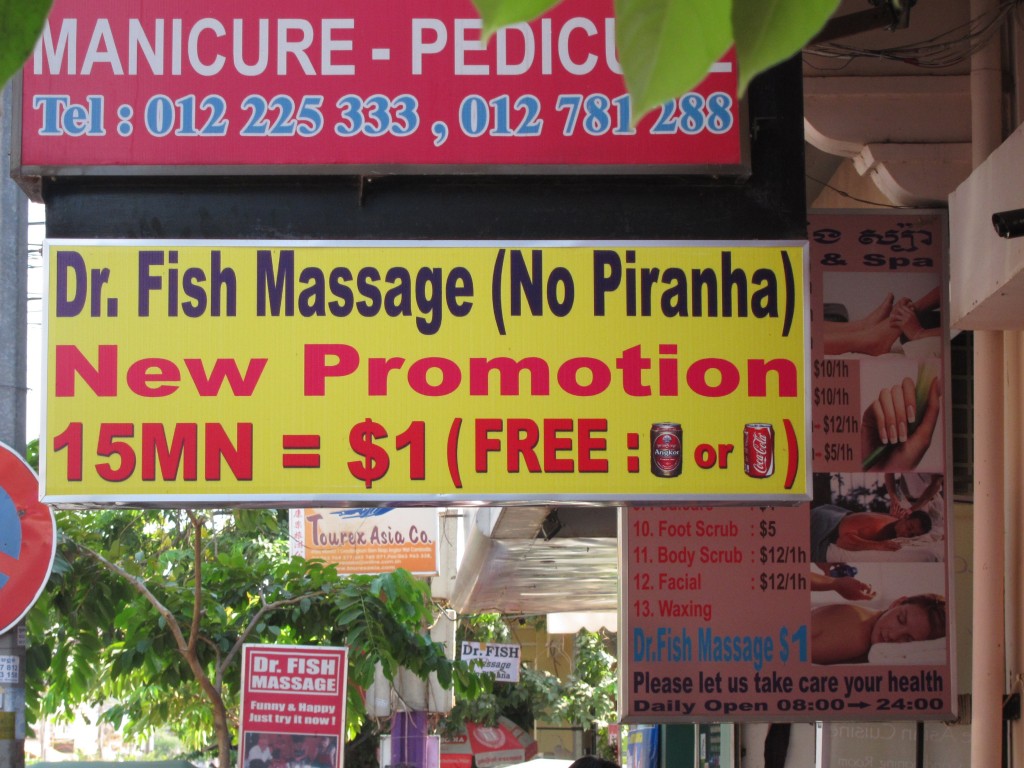
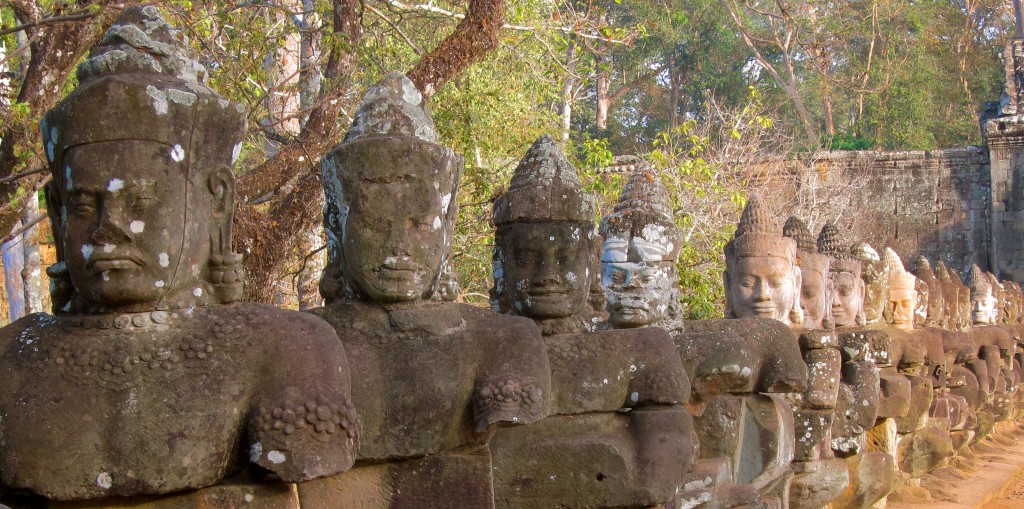
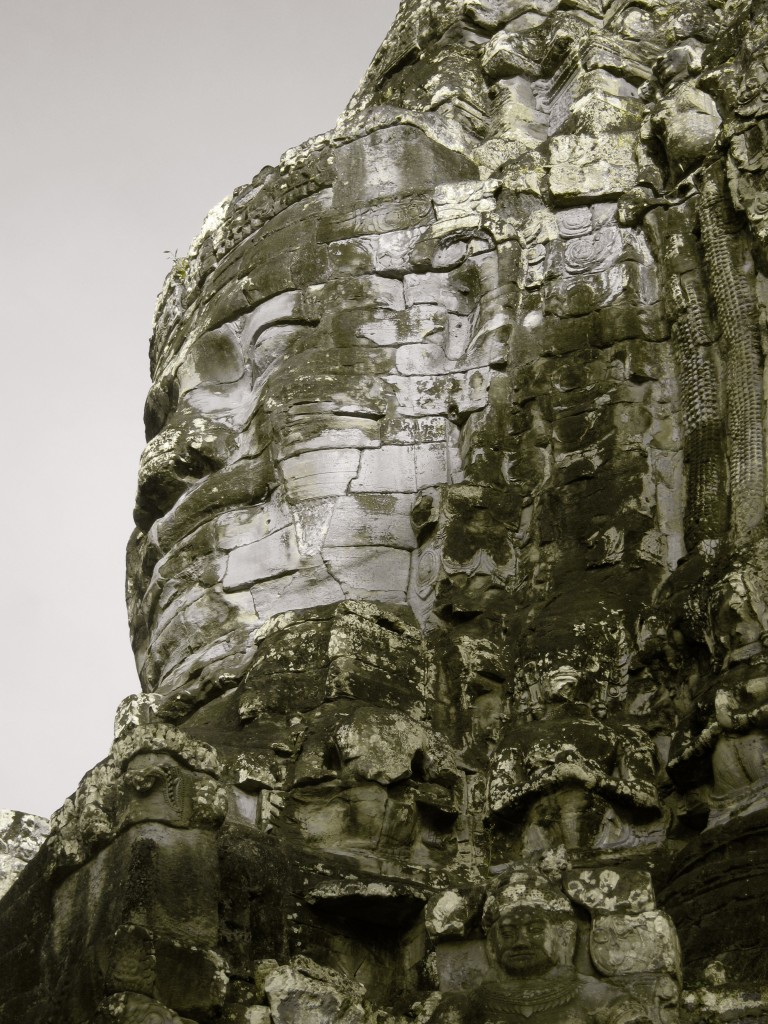
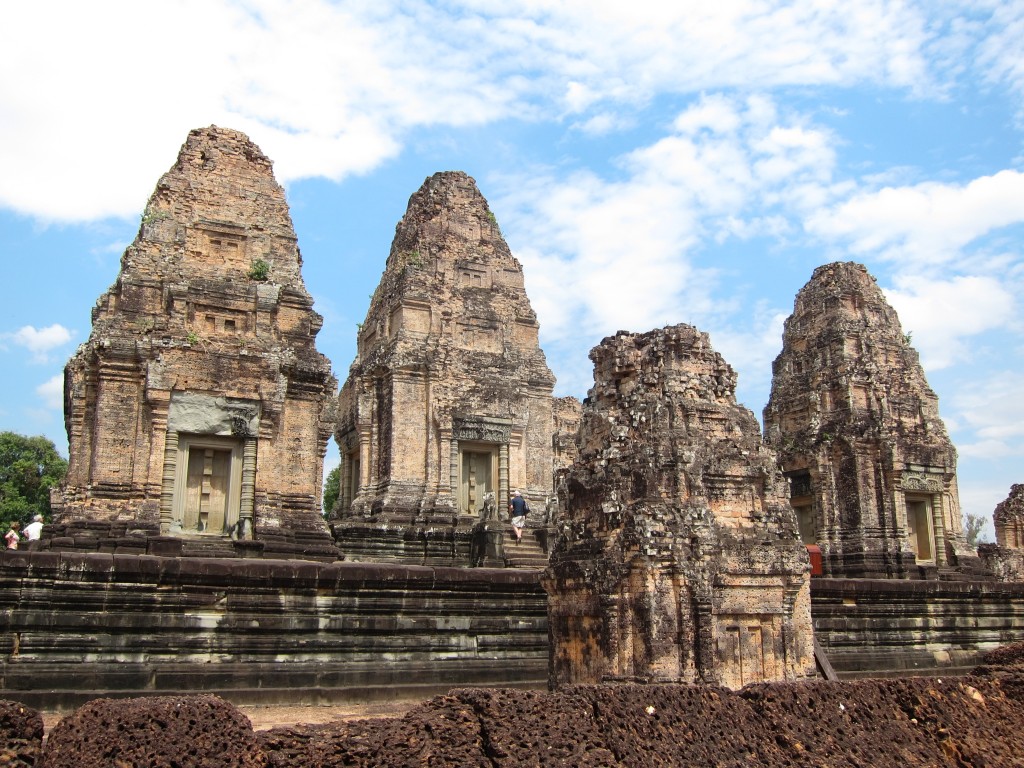
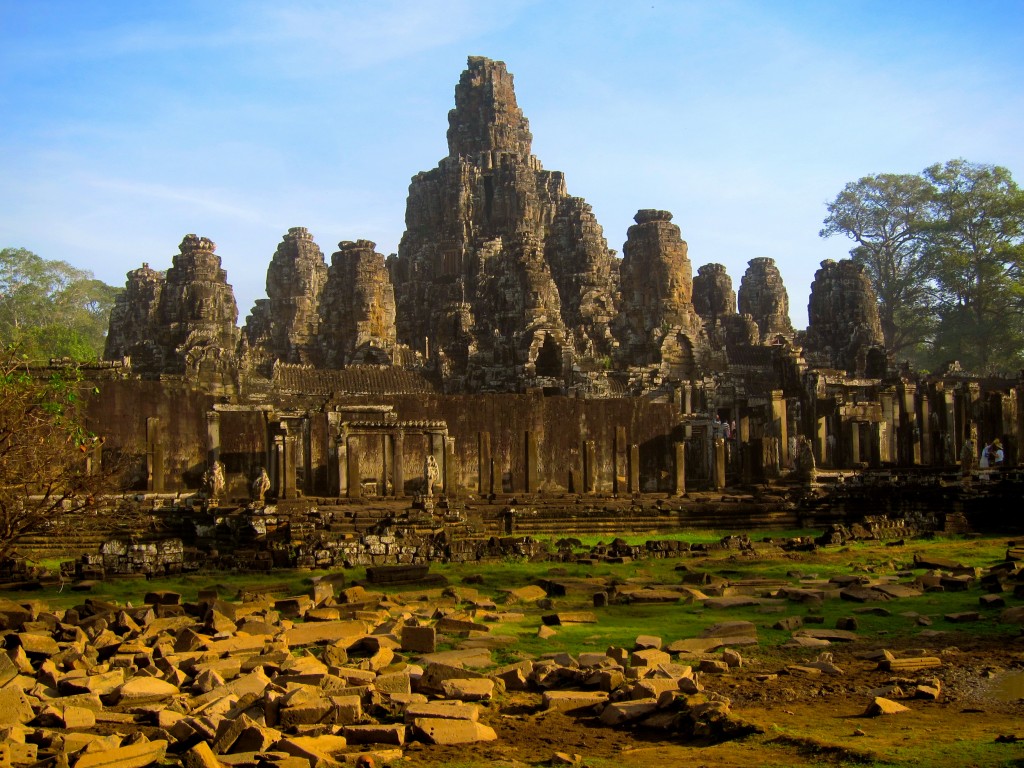
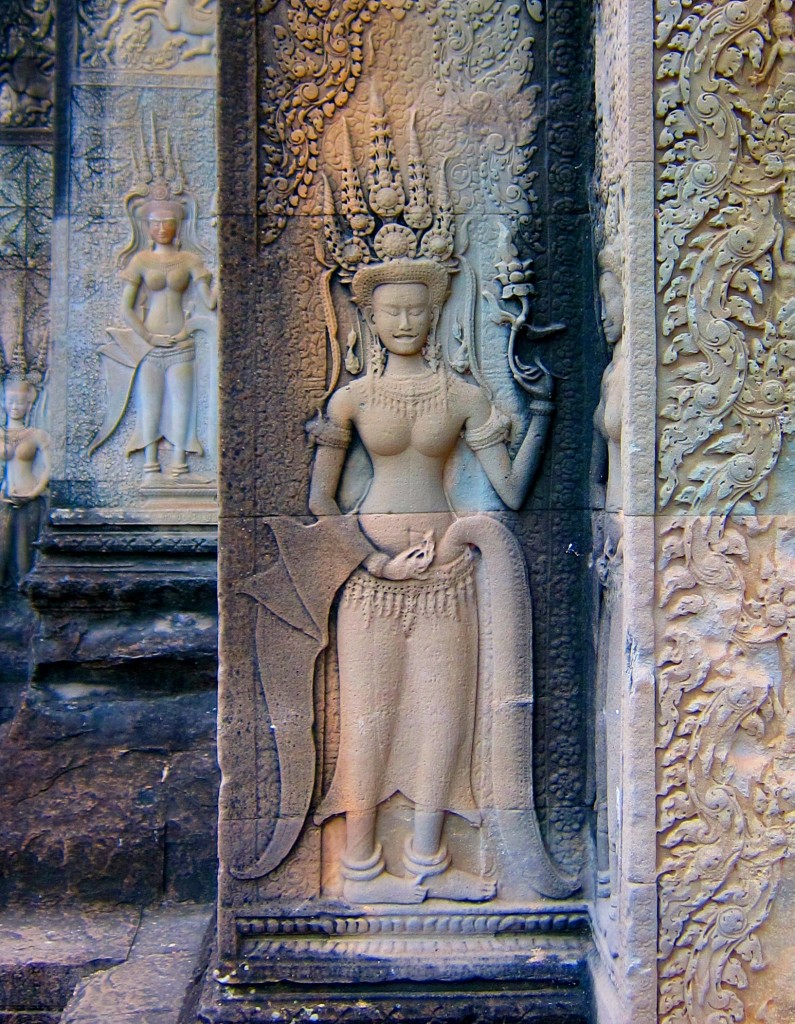
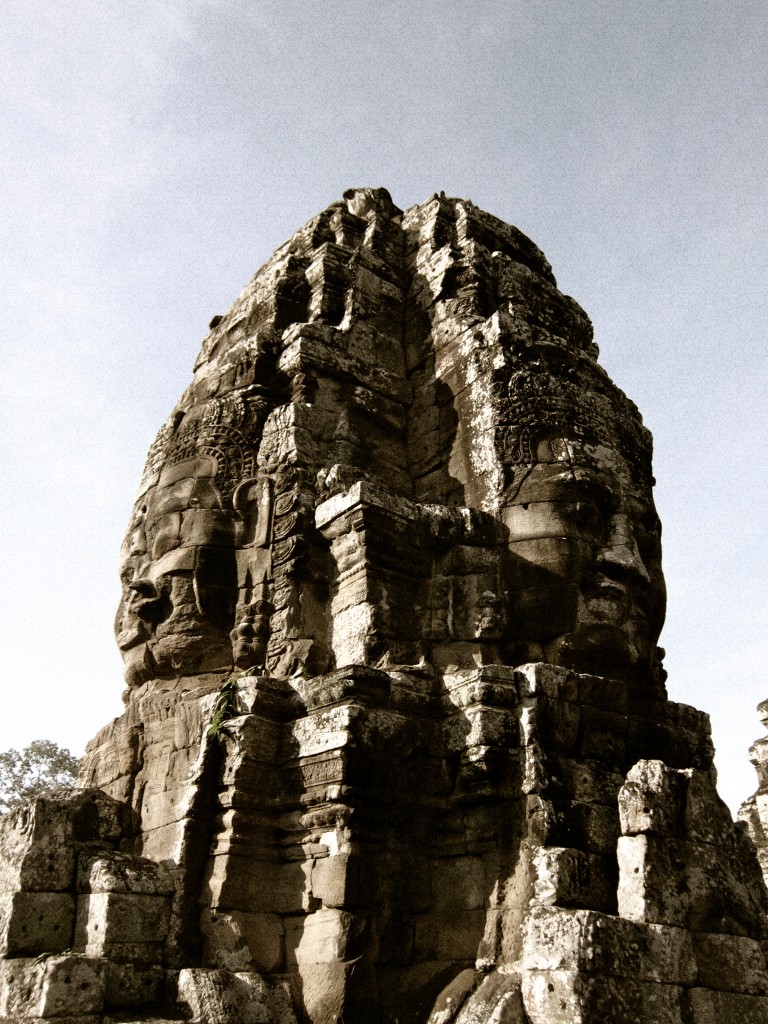
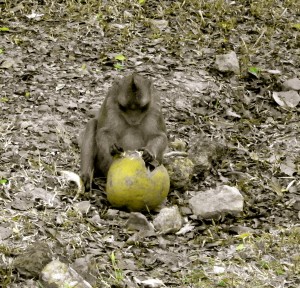
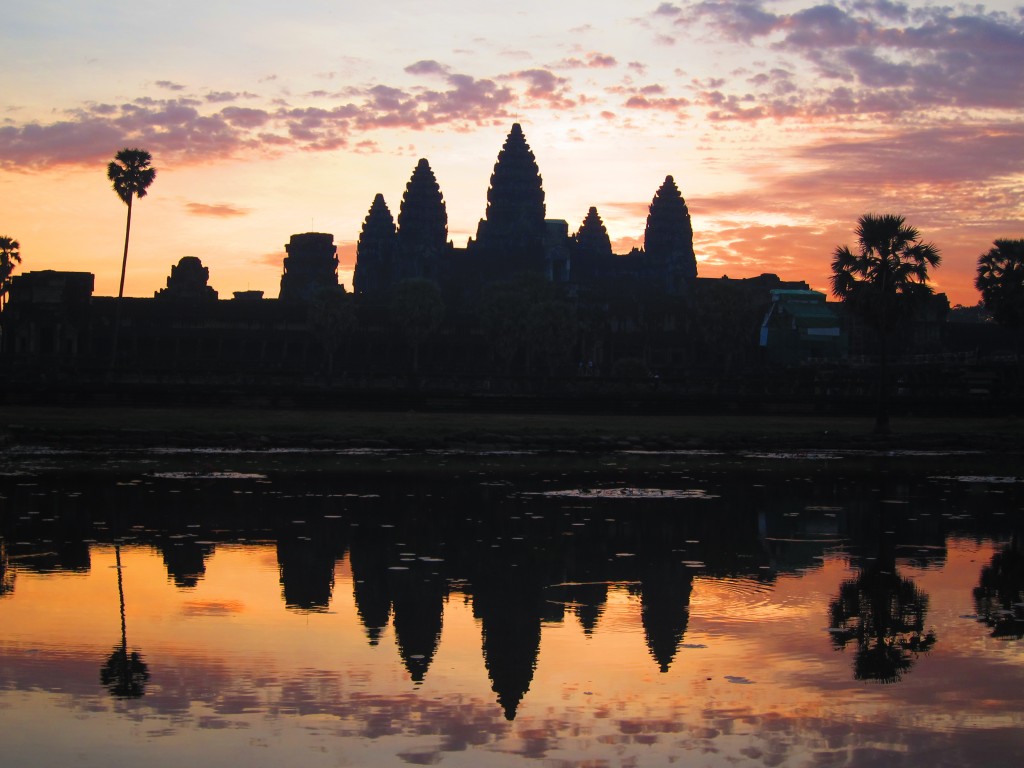
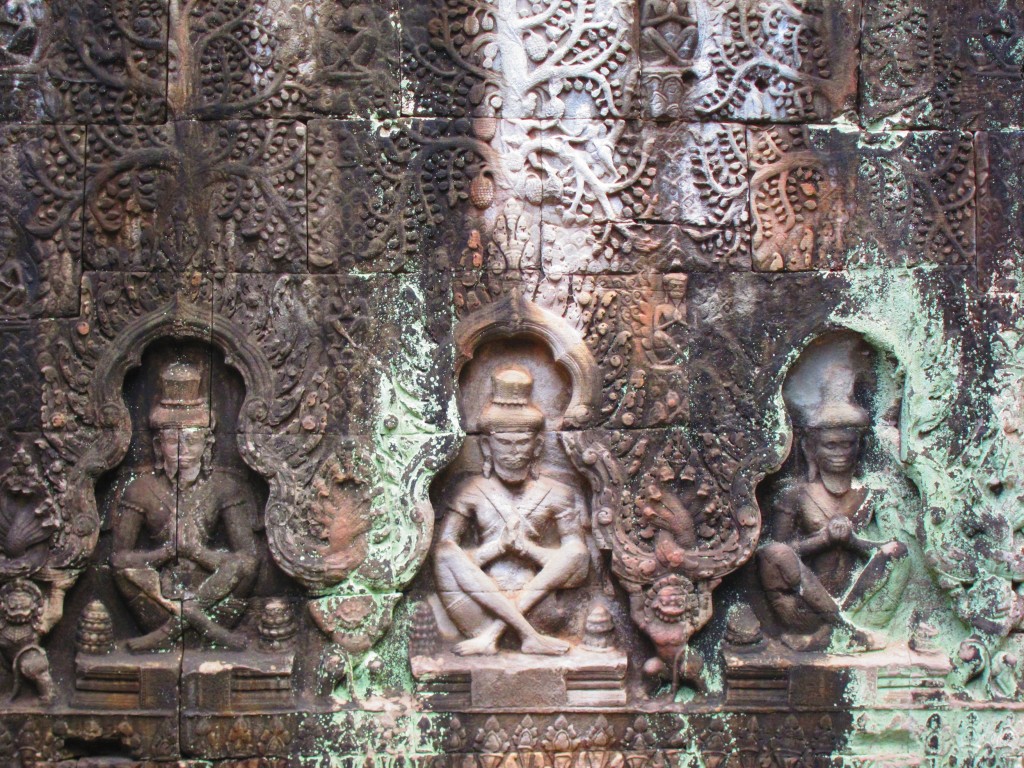
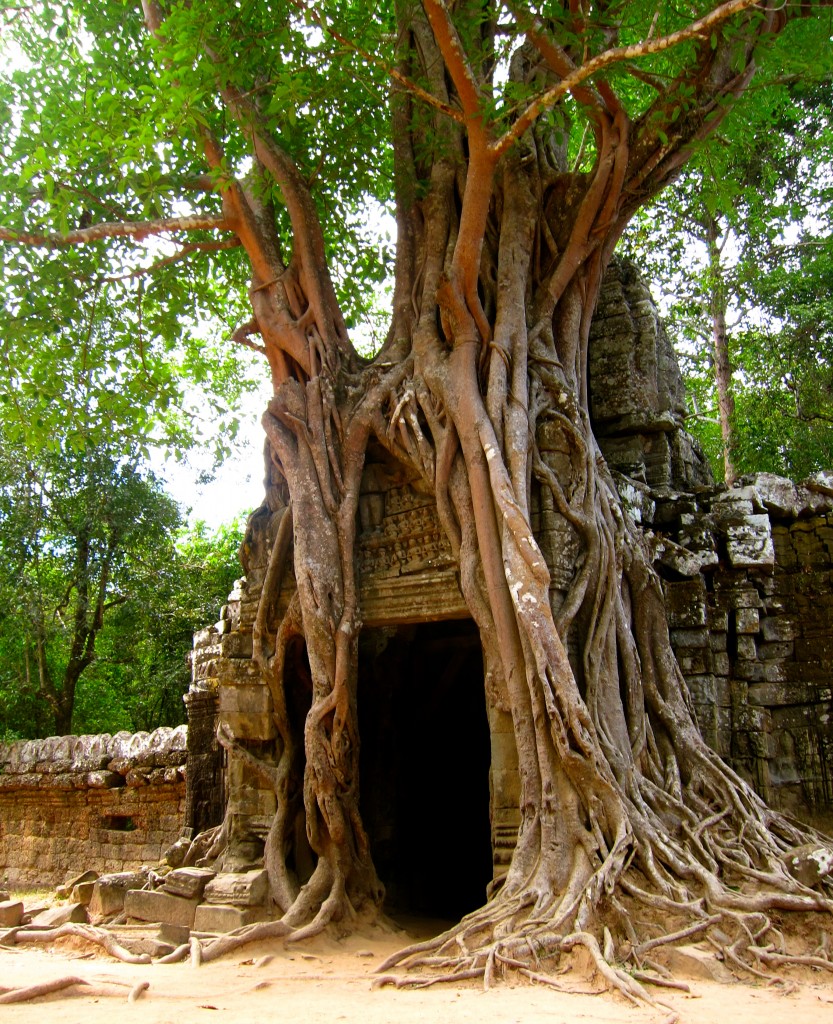
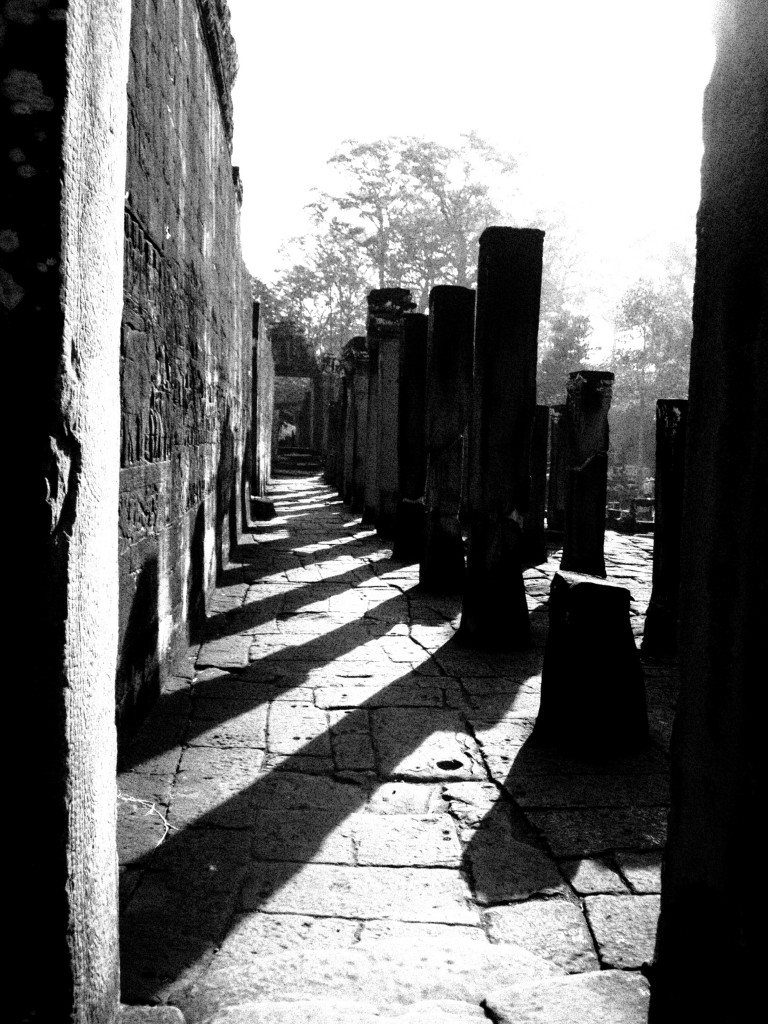
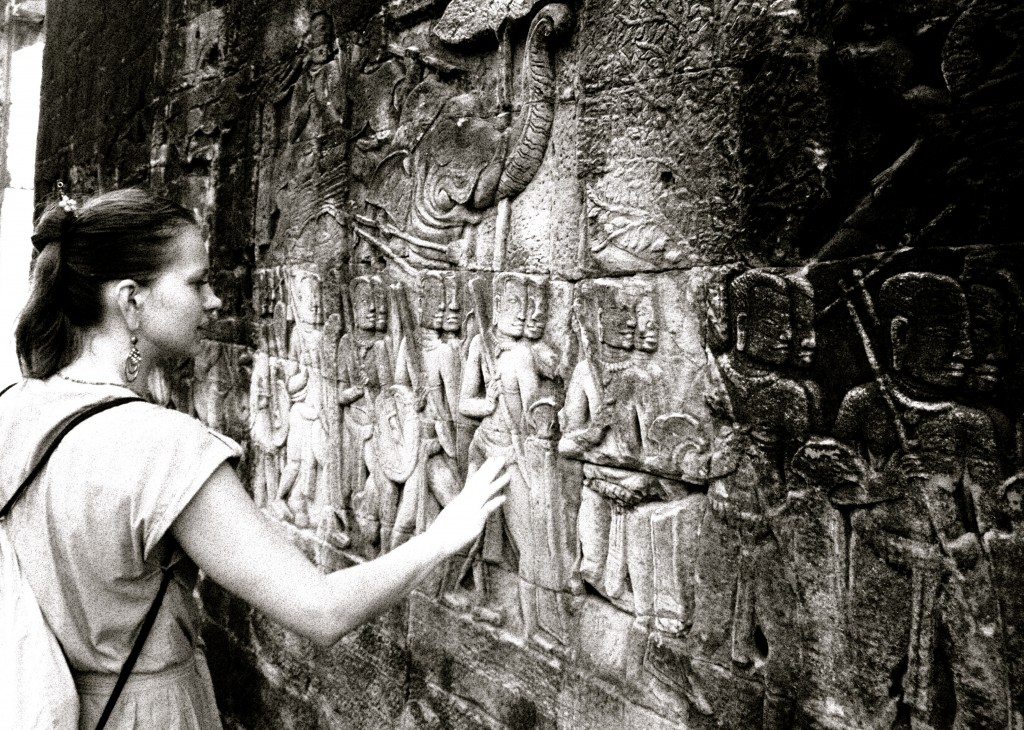
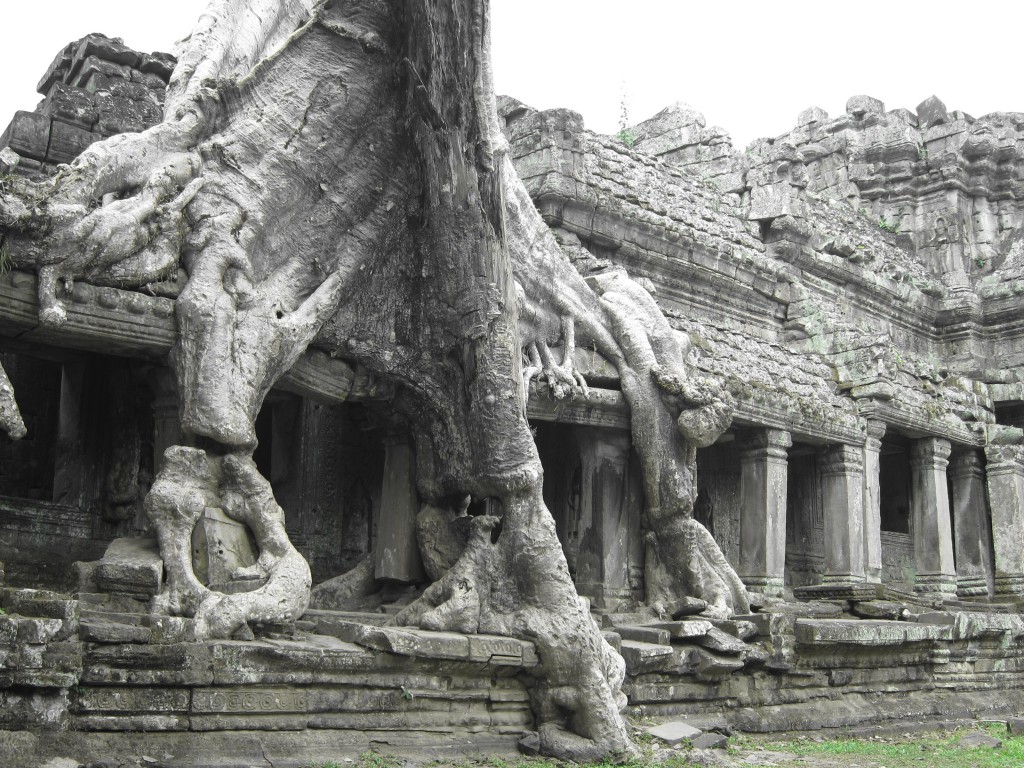
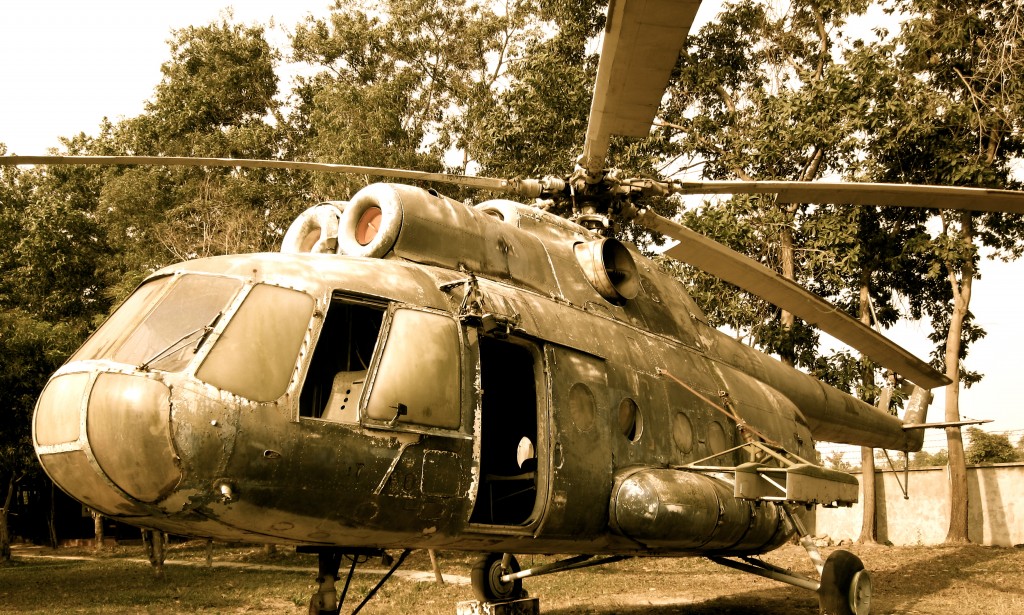
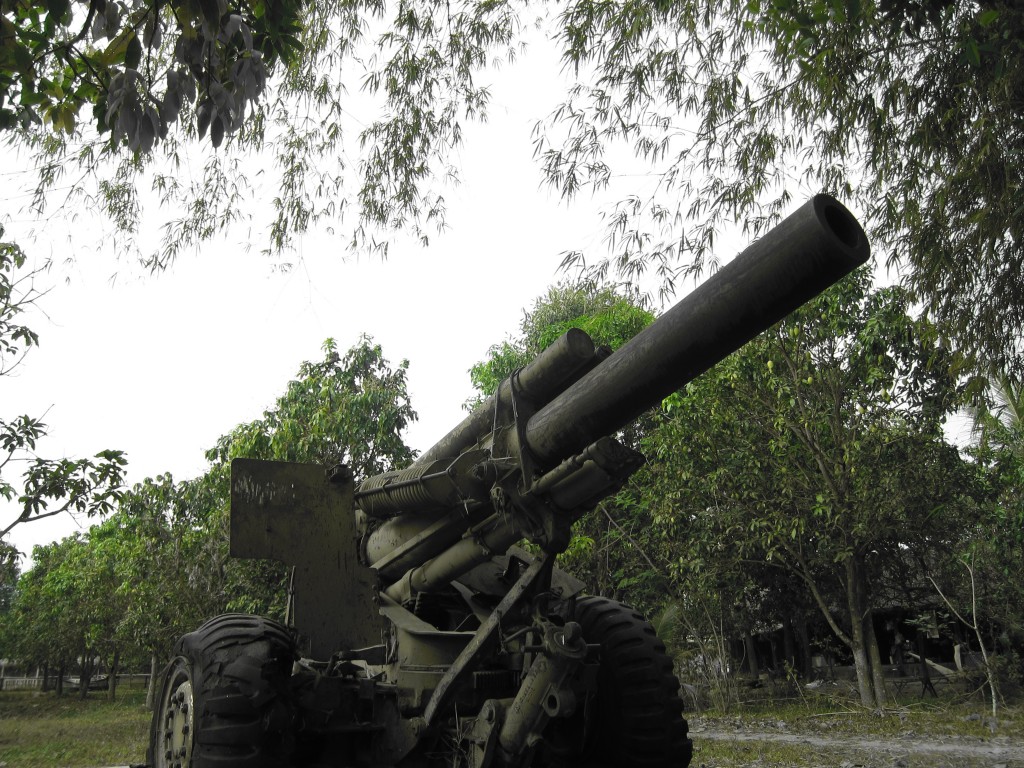

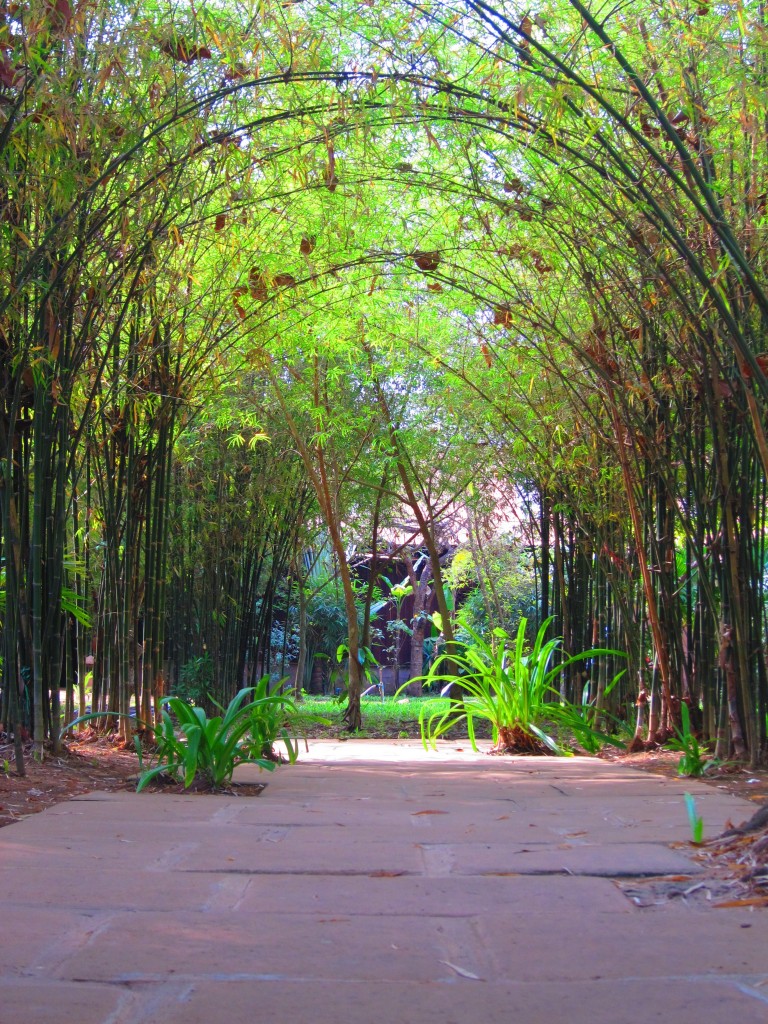
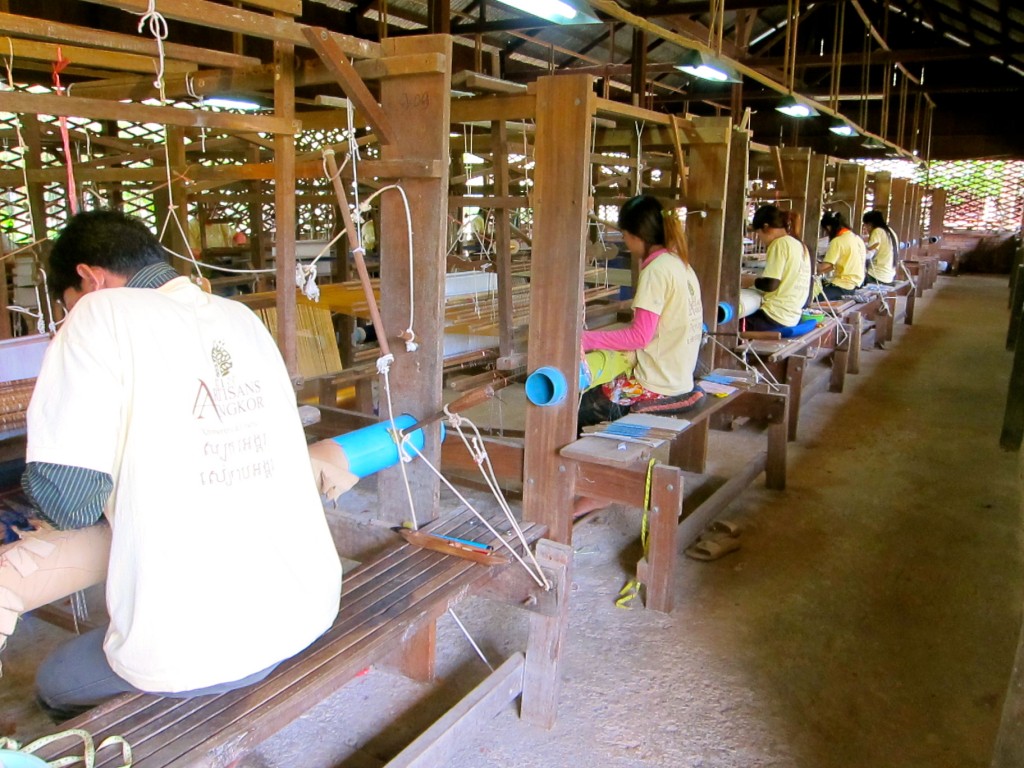

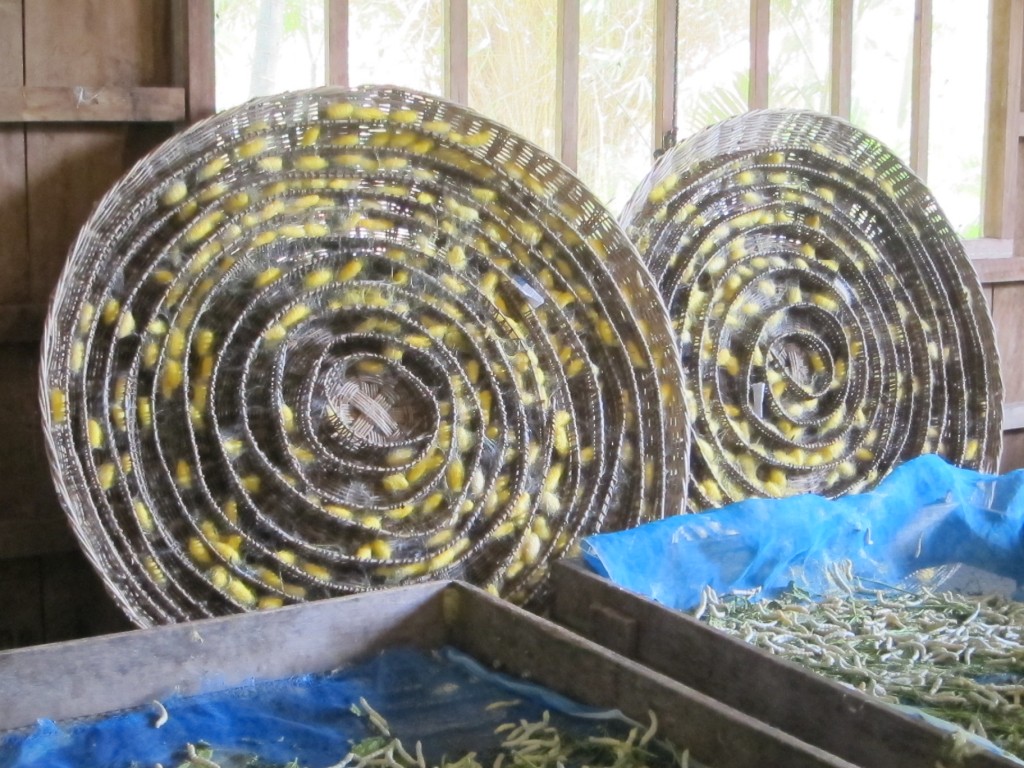
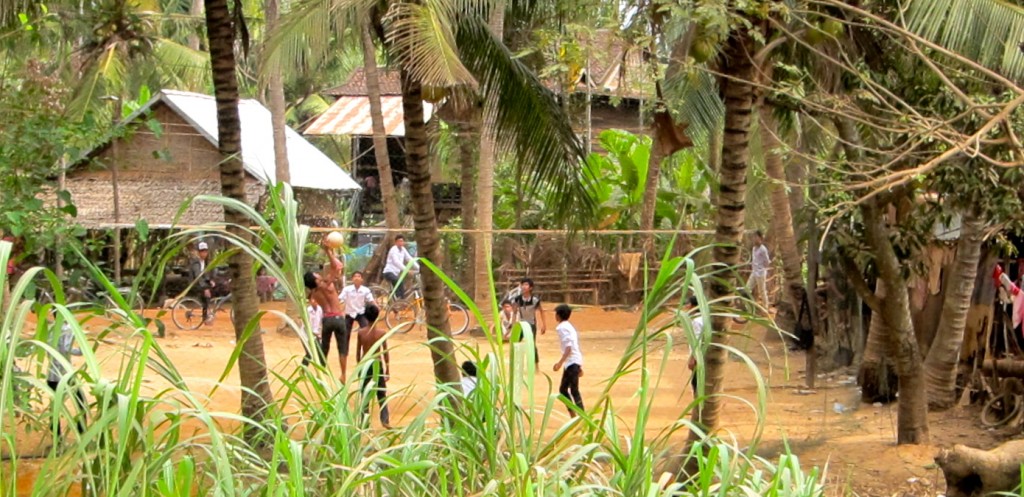
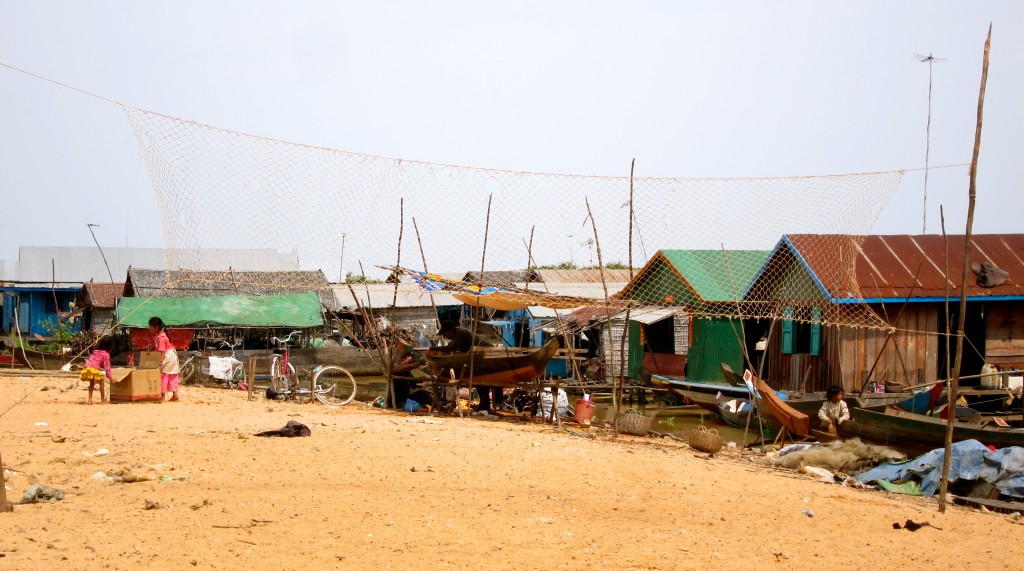
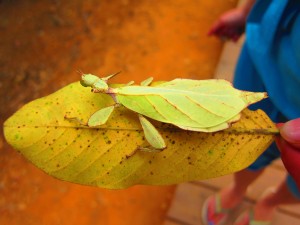
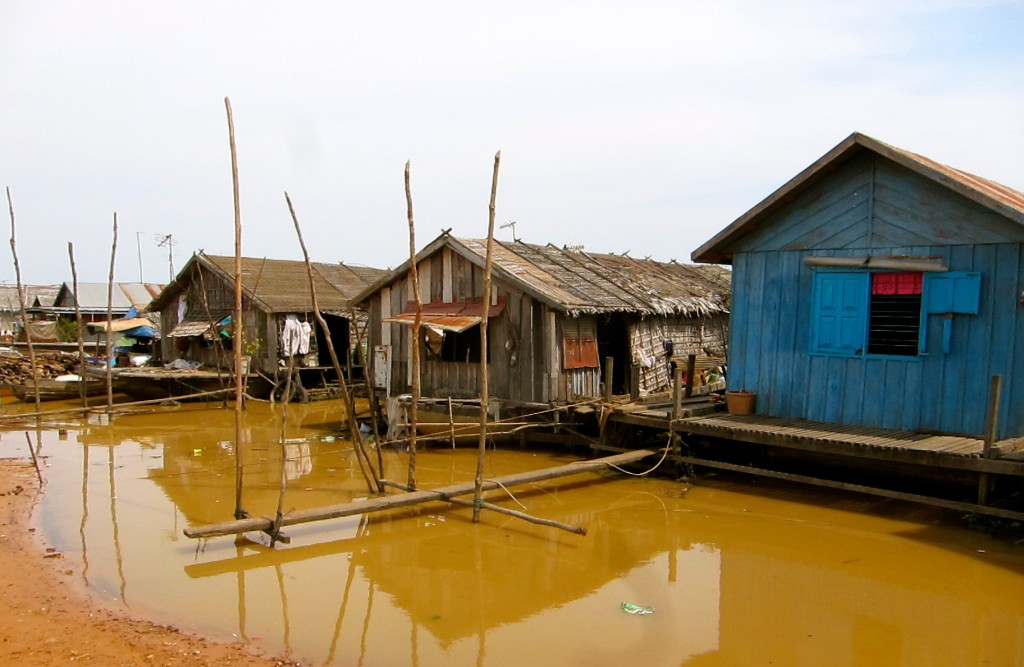
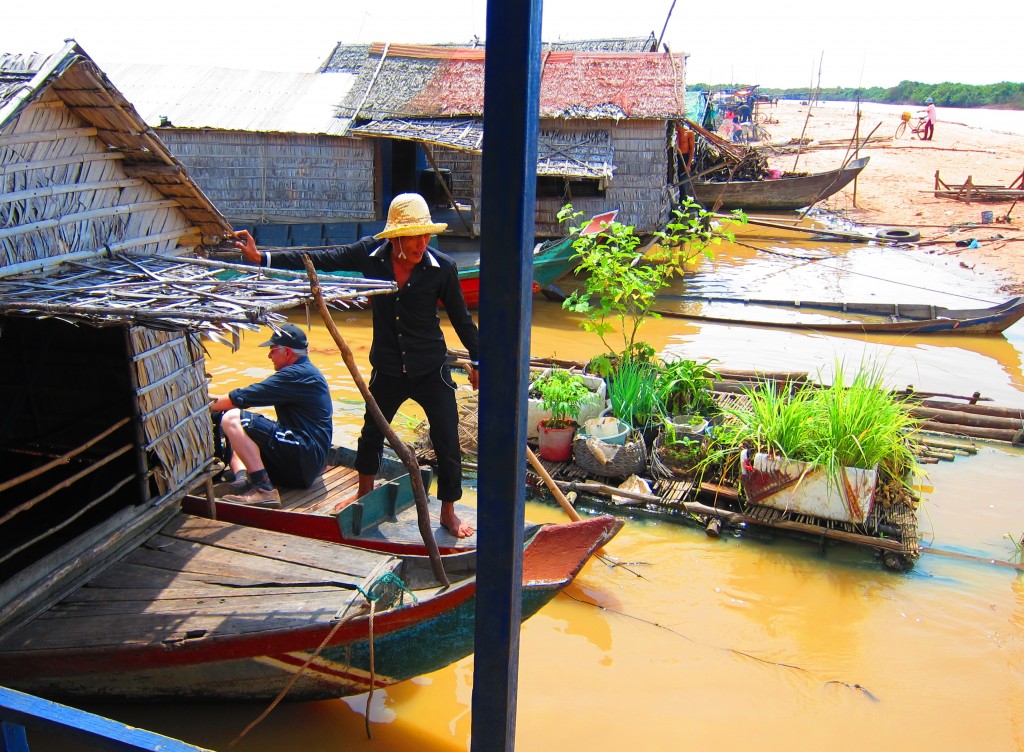

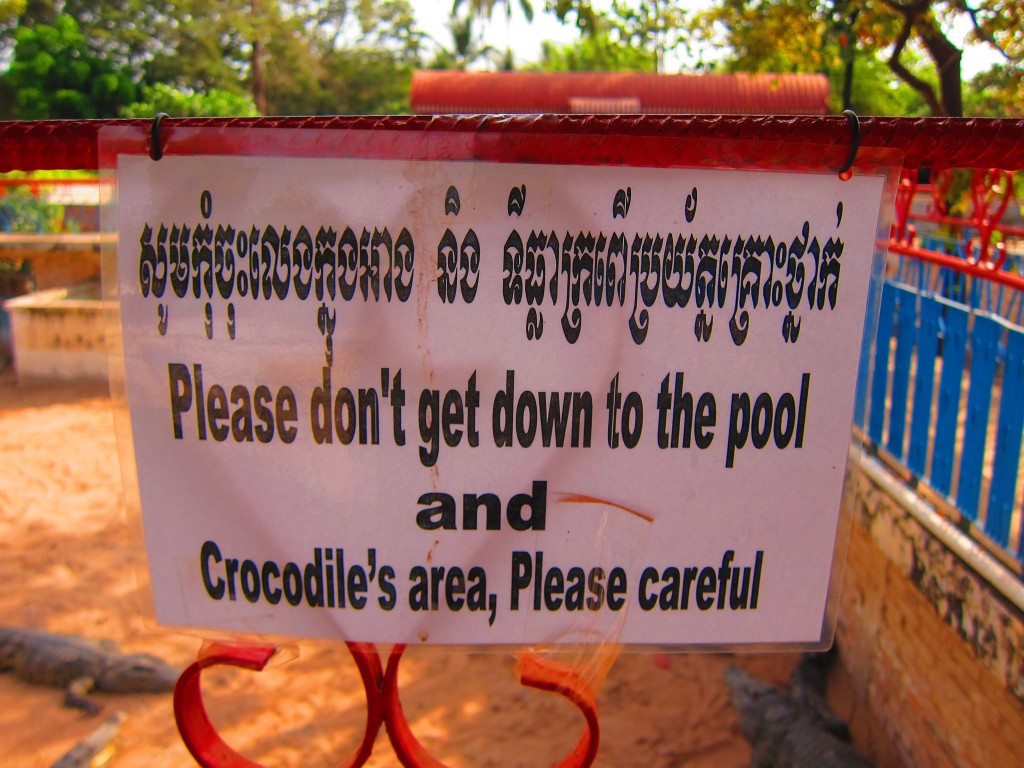
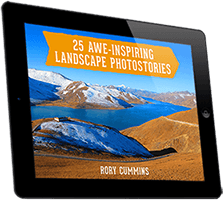
3 Comments... Join the conversation below
Just fabulous…again, Rory. What a fascinating country. Very poor I see, but the architecture is unbelievable. Almost surreal. I had to skip past the crocs, I cannot stand to look at them! Yikes. And those building made out of trees..wow. And I have to ask this question – did the fish massage really feel good? Do they leave bites on your feet and legs?
This was very well written. I am happy to see/read that you enjoyed your time in Cambodia. Although, you made me laugh when you said “The bamboo juice lady… I don’t know what type of bamboo she used but the juice was amazing.” That was sugarcane juice, not bamboo juice. LOL.
Haha, you’re right about that… It was my first time coming across that drink but now realize it was sugar cane as they have similar in both China and Malaysia. Either way, I’d recommend someone try it! Good stuff:)